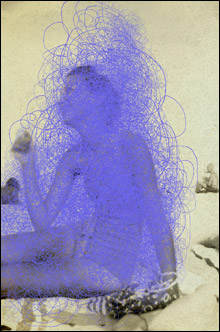
Matthew Swarts, Untitled |
How important would you say Ansel Adams is to the modern trends of digital art? If your first inclination is to answer, "Not at all," you're probably right. Apart from being silly, the question reminds us how far artists have come in their own artmaking practices — thanks, of course, to modern technology and a few good ideas. But a new exhibit at Boston University's Photographic Resource Center will explore this question pixel by pixel. Opening March 27, "SYNTAX," a group show organized by PRC curator Leslie K. Brown for this year's Cyberarts Festival, offers photographic and new-media works that embrace the concepts and constructs of digital information.Ansel Adams: New Landscapes, a 23-page book created by Luke Strosnider, is the most literal interpretation of Adams's influence in the show. The artist scanned several of the legendary black-and-white photographer's best-known works and examined the physical landscapes within each to find the shapes of histograms, or statistical bar graphs that display frequency data. It's a play on the Zone System, a programmatic technique created by Ansel Adams and Fred Archer in the early '40s to determine the most favorable film exposure and development. The final images of Strosnider's book strip out Adams's serene settings, leaving crag-like graph structures and mountain-esque peaks (in black and white, of course) composed entirely in Photoshop.
Newton artist Mark Stock's Inside the Bomb is a painterly 3-D rendering of the internal fluid dynamics at the moment of explosion. Brian Piana's works are abstracted versions of Web sites and animations that make reference to Internet use, among them Barack's Twitter, a deconstruction of then-candidate Obama's Twitter site, with simplified logos, a vacant text field, and a color grid. In Patti Ambrogi's pixel-inspired Cover Girls series, a photo of Martha Stewart is composed of 50,000 gingerbread cookie crumbs (the number of bucks she earned from insider trading). And Matthew Swarts's Untitled is a scan of his own dense and concentrated mark making laid over a family photograph.
"I chose to curate a show for this Boston Cyberarts Festival that acknowledges the vast changes our medium has undergone, even in the past decade," Brown explains via e-mail. " 'Syntax' showcases work that visualizes digital information and systems and meditates on the building blocks of digital itself, the pixels and programs."
Other visual art spaces participating in the sixth Boston Cyberarts Festival, April 24–May 10, include the DeCordova Museum, with its current survey of performative video by Ann Carlson and Mary Ellen Strom, and the South Shore Art Center, whose "Losing Ground" spotlights mixed-media photographer and printmaker Dorothy Simpson Krause. For more information about the festival, go to www.bostoncyberarts.org.
"SYNTAX" at Photographic Resource Center at Boston University, 832 Comm Ave, Boston | March 27–May 10 | 617.975.0600 or www.prcboston.org